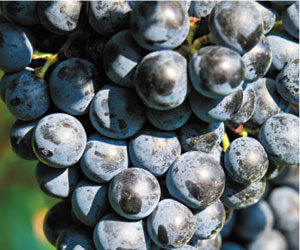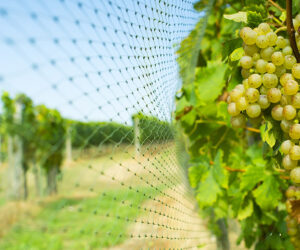There are two great subjects that fascinate me both academically and professionally — wine and mythology. I’ve never had the opportunity in more than 20 years writing this column to mention mythology, as it rarely intersects with my main goal in helping my readers grow and make better wine. Enter author, teacher, and mythologist Arthur George who moved to Santa Barbara, California wine country with his wife Elena and quickly became a working part of the vibrant small-production wine industry in the Santa Ynez Valley.
With the publication of George’s wonderful book this year, The Mythology of Wine, I was able to get to know Arthur a little better, see his COVID haircut (or lack of one), and tour his backyard Syrah vineyard from a safe 6-ft. (1.8-m) distance while we were both masked.
The vineyard was incredibly well manicured and for such a compact vertically positioned planting, the most impressive element to me was the consistency of trunk diameter and canopy growth. I would expect if we measured yield-to-pruning weight ratio, this vineyard would be within 5% consistency from most to least vigorous, except for a few blind positions on a vine or two.
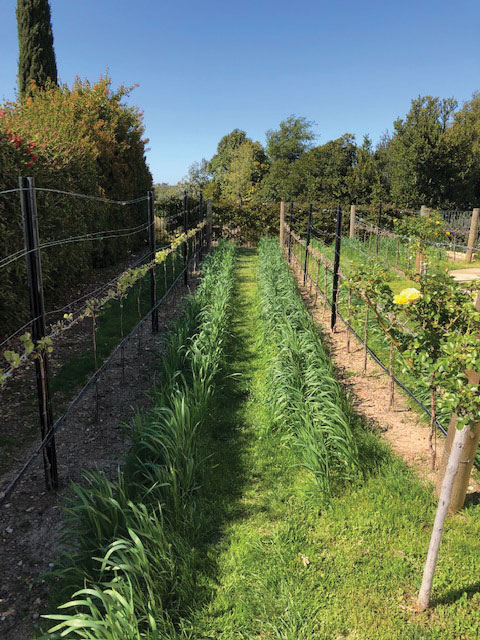
My takeaway from touring the vines, tasting Arthur’s wine, and seeing his winemaking medals from the WineMaker International Amateur Wine Competitions and others, was that his planning, execution, and fine-tuning in the vineyard could help almost any small-scale viticulturist to grow better fruit and see better balance in the rows. There is no doubt having the benefit of being on vaunted “terroir” helps — wines scoring 95+ points on the Robert Parker scale have been grown within a few golf shots of his home, but where potential meets planning and planning meets scheduled labor, that’s where great wine happens. Never by mistake.
Thanks to Arthur for answering my questions so thoroughly and helpfully, and I do strongly recommend picking up a copy of his book, The Mythology of Wine, on Amazon or at a local brick-and mortar (they can order it).
. . . where potential meets planning and planning meets scheduled labor, that’s where great wine happens.
What inspired you to plant a vineyard in your Solvang backyard?
I wanted not only to make wine, but to do so from grapes that I farm myself. That way I’m responsible for the whole process, total vertical integration.
Did you do the install by yourself?
I had help from local professionals who install and maintain vineyards. I designed and marked out the rows myself. Since the soil is really hard once you get a foot (30 cm) or so down, I had to break it up. So I had a backhoe come in and dig a trench 3-ft. (91-cm) deep and 3-ft. (91-cm) wide where the rows would go, and replace the dirt back where it came from. Then the installers brought an auger to drill the holes for the end posts and installed them together with the other posts and wires. I had my regular landscaper/gardener install the irrigation system.
I couldn’t find anyone who would sell me rootstock in the small quantities that I needed, so I decided to do own-rooted vines from cuttings, since my soil type is low-risk for Phylloxera. I got them from Steve Gerbac, the Winemaker at Rusack, where I’m in the wine club. I specified what clones I wanted (174, 383, 877, and Estrella) and he gave me about 95 cuttings in December 2016. I got them to take root in planters in my garage over the winter. In late March 2017 I invited the professionals back to help plant them. They showed me how to do it, and I planted some and they planted the rest. I kept the remaining cuttings to use as replacements for those that don’t survive. About 30% of them did not survive and had to be replaced, which I did myself. I made a map of the vineyard showing what clone every vine is, including the replacements. Estrella is the most populous clone.
How did you decide on Syrah?
Here in Solvang we are in a kind of no man’s land, too hot for Chardonnay or Pinot Noir (these varieties are grown mainly in the Santa Rita Hills) and not hot enough for Sauvignon Blanc, Cabernet Sauvignon, and Merlot (more typical of Happy Canyon). I was always thinking in terms of a red, so I was thinking of Syrah from the beginning, since I know it is grown in Ballard Canyon nearby (Rusack, Stolpman, Jonata). Then Ken Brown of Ken Brown Wines (who was then my neighbor from just down my street) kindly came over to have a look after the trellising was installed, and he confirmed that Syrah is the best choice for my location.
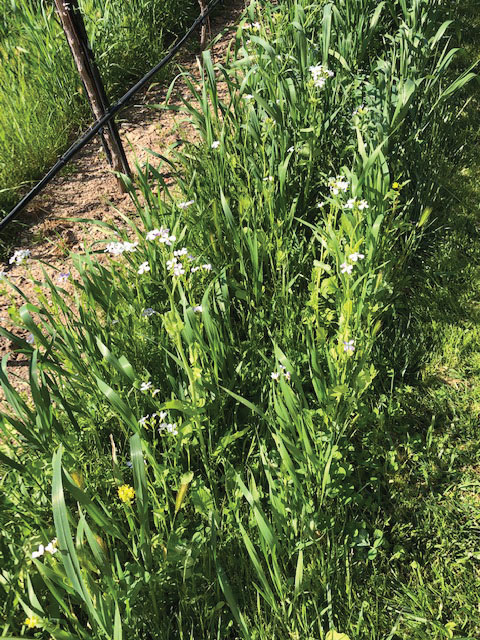
The vineyard is beautifully trellised, managed, and manicured. What are your secrets to such straight trunks and nearly perfect spur pruned positions?
The cuttings were originally in growth tubes, secured by thin metal stakes. When I took off the growth tubes I tied the vines to the stakes so they grew straight up to the cordon. I then carefully and gradually bent them over onto the cordon wire, to which I also tied them as they grew sideways. After the vine was on the cordon and the trunk seemed like it would not bend from any stress, I removed the stake from the ground. On the cordon I gradually loosened the ties as the vine grew thicker so as not to constrict them (which I still have to do every few months). I use Velcro ties so this is easy to adjust.
Regarding the pruning, I studied how to do it (including in viticulture class at Allan Hancock College) and watched a lot of videos. I also had a couple of winemakers that I know from my winemaking club (Central Coast Home Vintners’ Association or CCHVA) as well as a professional come over to guide me. I’ve made a few mistakes, but fortunately not too many. My practice has been to err on the side of leaving more buds, in case some of them don’t develop well. I figured that if there are too many shoots I can always thin them out, which I indeed had to do. But now I’m getting more confident about leaving fewer buds.
What does your spray calendar look like? First sprays? Intervals? What do you use?
I start spraying once the longer shoots are 8–10-in. (20–25 cm) high, usually in April, and I spray until it starts getting really hot, usually around veraison or a little before that. The average interval is 7–10 days, but if it rains then I spray immediately thereafter. The sulfur product that I use is called Microthiol, a powder dissolved in water in my backpack sprayer.
(Wes Interjects: Powdery mildew and Botrytis are destroyed in arid heat spikes, so temperatures in the triple digits (>38 °C) usually “reset” the mildew/rot spray timer.)
The other thing I do to prevent mildew is to watch for bunches of leaves together. When I see any developing, I thin out the leaves to allow air to pass through and keep the leaves dry. I had absolutely no mildew problem this past growing season (2020).
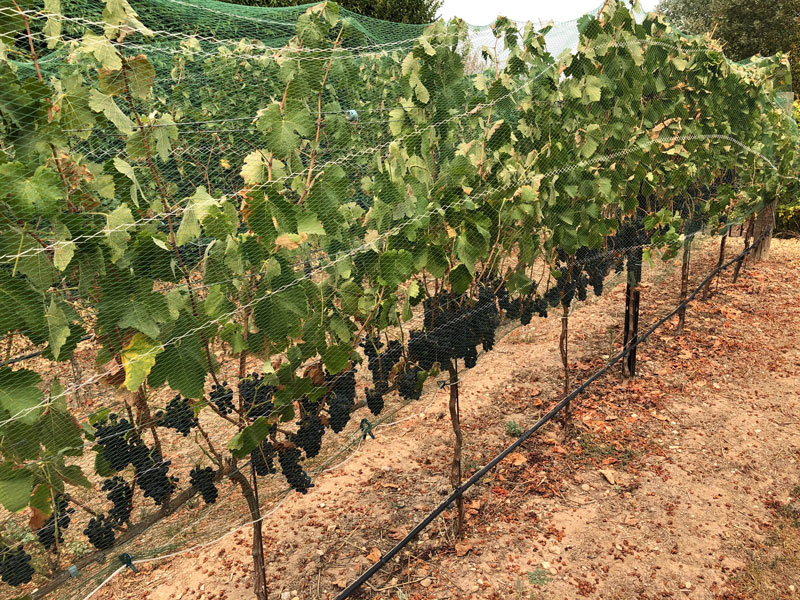
When is your normal budbreak, veraison, and harvest?
Budbreak is usually the second or third week of March, veraison is late July. My first harvest, in 2019, was on October 7, which in retrospect was probably a week or so too early (see regarding numbers later). In 2020 due to the heat spikes in the summer the grapes ripened faster, so the main harvest was on September 22, but in one part of the vineyard the grapes (mostly smaller clusters) were ready earlier (27 °Brix) so I picked that a little over a week earlier and fermented that separately, put a layer of argon gas on it, and then blended it with the must from the main harvest before going to press.
What numbers do you like for harvest?
I only have had two harvests and both vintages are too young to drink, so there is no real track record yet and it is hard for me to say. In 2020 I picked at 3.48 pH and about 24.5 °Brix, which based on barrel tasting so far seems to have been about right. I picked more based on pH (and tasting the grapes, and the amount of shriveling going on) than Brix, because the pH goes up during malolactic fermentation and I wanted a final pH of no higher than around 3.6. In 2019 the pH and Brix were each about one-tenth lower, which in retrospect was a little too early. I picked then because some of the grapes were starting to shrivel and they tasted good, but in the end the wine lacks some fruit, which so far is overshadowed by some green tannins that may or may not work themselves out. (I’m not having this problem with the 2020 vintage.) The other reason for that is that one night the fermentation temperature got too high at 94–95 °F (34–35 °C) (before I quickly cooled it down with ice bombs), which can decrease the fruitiness, I’ve read.
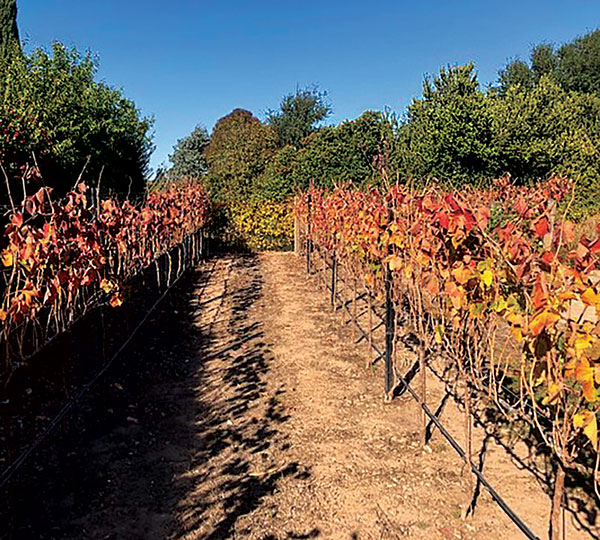
How many vines and what is your average yield?
I have 52 vines. In 2019 they yielded almost 200 lbs. (91 kg), in 2020 about 215 lbs. (98 kg), which got me 13 gallons (49 L) of wine in bulk storage. That gets me about 65 bottles — about one to drink per week after subtracting those used for gifts, wine competitions, etc. By next year or the year after I hope to be up to 250 lbs. (113 kg), once the vines are mature.
What’s your protocol when it comes to yeast and must treatment of that precious estate fruit?
For my Syrah I use D254 yeast together with GoFerm Protect yeast food. A little before inoculating I add pectic enzyme.
Anything else you would like to share with other hobby or professional viticulturalists?
I do annual soil testing in December to check for any nutrient deficiencies or excesses, using AgLabs in Santa Maria, California. I have them take two samples from different parts of the vineyard, focusing on spots where I have concerns about how particular vines are performing. (When I installed the vineyard, I took two samples for a different reason. I figured that the front and back sections were different and out of balance because the front had had a lawn while the back was mulched, meaning that the back part would be nutrient-poor. It took a couple years before the two parts fell into balance, before any harvests.) The lab tells me what nutrients I need to apply in what quantities (on a per acre basis, so I have to do some math). I apply the nutrients by hand rather than through the irrigation system because the vineyard is small and I want the nutrients to be applied not just directly next to the trunk under the emitters but throughout the whole breadth of the root system.
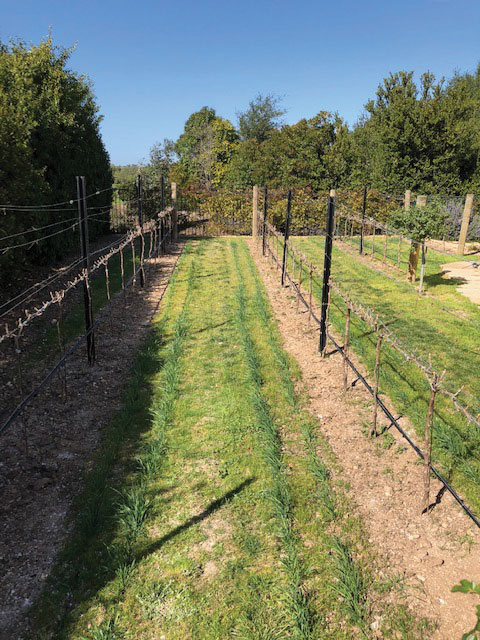
(Wes interjects: This type of soil testing is great and gives a helpful result, but I suggest doing a petiole tissue analysis from the vineyard in the middle of, or right before, flowering. You can check with an agricultural laboratory for the protocol for this.)
I plant a cover crop in early December, consisting of a mix of several kinds of plants available from farming/garden suppliers. While it is growing, it helps temper the vigor of the vines. I then till it under once the vegetation starts to get out of control (late May or early June), and the crop’s nutrients enrich the soil. I don’t till too deeply, just enough to get under the crop to be able to turn the plants over, about 2–3 in. (5–7 cm) deep. I almost never encounter a root from the vines. Since there is generally no rain that time of year and the vineyard is small, I then hose it down so that the plants will decompose faster.
The lab tells me what nutrients I need to apply in what quantities.
I planted the rows along a north-south axis so that the vines and clusters will get sun on both sides. I have shade issues in the vineyard, which is in four rows on the west side of my backyard between my house and a tall hedge along the property line. The house casts a shadow on most of the vines until mid-morning, especially on the two rows closest to the house, while the west hedge casts a shadow in the late afternoon, especially on the two western rows. Only about 20% of the vines have ideal, totally unblocked sunlight, in two rows in the northeast section north of the shadow of the house. So I decided to plant the rows 8 ft. (2.5 m) apart rather than 6 ft. (1.8 m) to minimize the shadows that one row casts on another and gain sunlight. (With rows 6 ft./1.8 m apart, I would have had an extra row and more grapes, but I’m after quality not quantity.) Also, for the western row along the hedge, I elevated the cordon (and therefore the whole canopy) 6 in. (15 cm) higher than the other rows to get it up into the sun more.
Being a mythologist, I’ve carried my interest in mythology over into my viticulture and winemaking. (I suppose not many mythologists are farmers, or vice versa.) So I call my vineyard Mythic Vineyard, which is specified on my label for my Syrah, and the image on my label for all wines is that of the Greek Horae dancing, from the painting “Horae Serenae” by Edward John Poynter (1894). My label won a gold medal at the 2019 Orange County Fair wine label competition. (Wes: I was a wine judge at that Competition, and I voted for your label!)
So far, it is proving harder to make good wine with my own grapes than with professionally farmed grapes from good commercial vineyards. On the other hand, I understand that wine from the first harvest or two in any vineyard is not going to be as good as from later harvests. My hope is that once the vines are mature my almost daily micromanagement will prove to be an advantage over the grapes farmed on a mass scale that I can just buy.
Wes: Thanks again to Arthur George for taking the time to help us understand his vineyard management and winemaking so we can endeavor to have rows of vines as tidy as his. Arthur and I did a great one hour interview on Wine Mythology that you can access for free here: https://www.youtube.com/watch?v=DtWhqP4EbOM


